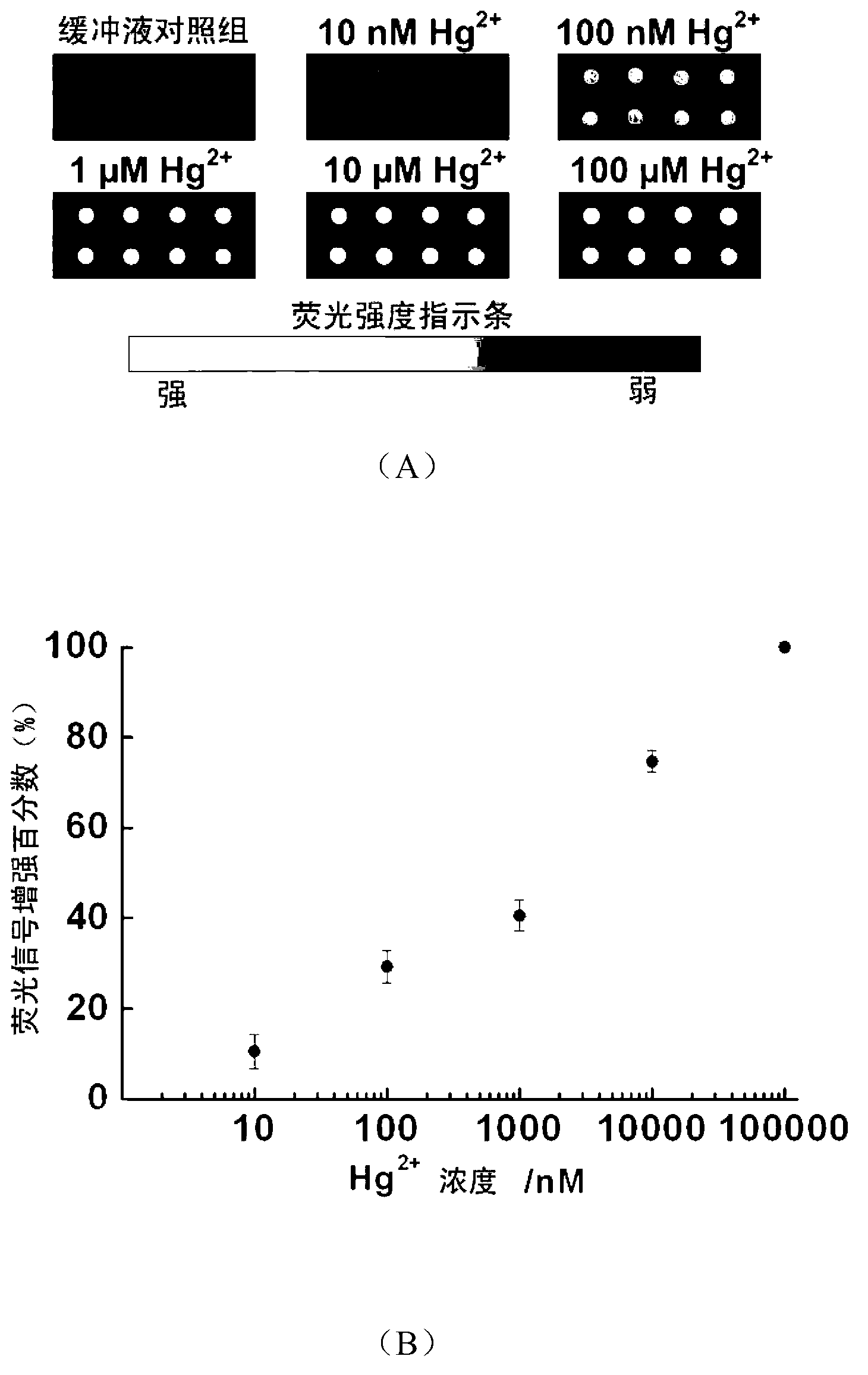Fluorescence-enhanced Hg<2+> detection chip based on oligonucleotide chains and method thereof
An oligonucleotide and detection chip technology, applied in the field of biological analysis, can solve the problems of false positives and false positives in the working mode, and achieve the effects of simple and easy production methods, low cost, and easy understanding and expression
- Summary
- Abstract
- Description
- Claims
- Application Information
AI Technical Summary
Problems solved by technology
Method used
Image
Examples
Embodiment 1
[0030] Embodiment 1: utilize probe A, probe B and probe C to prepare Hg 2+ Detection chip.
[0031] Probe A was made into a solution with a concentration of 10 μM, then mixed with the same volume of spotting solution, and arrayed on the surface of an aldehyde-modified glass slide with the microarray chip production system of Cartesian Company, placed at room temperature, 70% Store in relative humidity for 48-72h for fixation, then immerse the slide in 0.2% SDS at room temperature for a few minutes, then immerse in pure water for a few minutes, then immerse in 0.2% SDS twice, each time for 2min, then immerse in pure water Twice, 2min each time, dry. Hybridization solution (10mM MOPS, 100mM NaNO 3 ,pH7.2) Probe B was diluted to a final concentration of 2-5μM, dropped on the chip, covered with a cover slip, and hybridized overnight at room temperature. The next morning, place the chip at 4°C for 30 minutes, then at 25°C for 15 minutes. Then wash with 0.2% SDS, 2×SSC, 0.2×SSC ...
Embodiment 2
[0032] Example 2: Using probes A, B, and C to prepare a chip to detect 100nM Hg 2+ Solution, and step-by-step scanning of fluorescence intensity photos.
[0033] The chip preparation method is the same as that in Example 1, after the probe A is immobilized, after the probe B is hybridized, and after the probe C is hybridized, use the chip signal analysis system Scanarray 3000 of General Scanning Company to scan the photos ( figure 2 A-C). 10mM MOPS, 100mM NaNO 3 , pH7.2 diluted to prepare 100nM Hg 2+ solution, the Hg 2+ The solution is added to the prepared chip spots. After reacting at room temperature for 1 hour, take out the chip, and use 10mM MOPS, 100mM NaNO 3 , washed with pH7.2 buffer solution for 3 times, dried, and scanned with Scanarray 3000 chip signal analysis system of General Scanning Company ( figure 2 D).
[0034] The results showed that the chip had no fluorescence after probe A was immobilized; after hybridization of probe B, the fluorescence intensi...
Embodiment 3
[0035] Embodiment 3: Utilize the chip prepared by probe A, B, C to detect different concentrations of Hg 2+ .
[0036] With 10mM MOPS, 100mM NaNO 3 , pH7.2 were diluted to prepare 10nM, 100nM, 1μM, 10μM, 100μM Hg 2+ , plus different concentrations of Hg 2+ The solution was placed on the prepared chip spots at room temperature and reacted for 1 h. With 10mM MOPS, 100mM NaNO 3 , washed 3 times with pH7.2 buffer and dried. The photos were scanned with the chip signal analysis system Scanarray 3000 of General Scanning Company ( image 3 A) and analyze the results ( image 3 B).
[0037] The results showed that in Hg 2+ In the presence of ions, the fluorescence intensity at the chip spot increases, and when Hg 2+ The higher the concentration, the greater the enhancement of fluorescence intensity. When Hg 2+ When the concentration is 100nM, compared with the fluorescence intensity of the buffer group, the fluorescence intensity at the spot is enhanced by 30%, with the inc...
PUM
 Login to View More
Login to View More Abstract
Description
Claims
Application Information
 Login to View More
Login to View More - R&D
- Intellectual Property
- Life Sciences
- Materials
- Tech Scout
- Unparalleled Data Quality
- Higher Quality Content
- 60% Fewer Hallucinations
Browse by: Latest US Patents, China's latest patents, Technical Efficacy Thesaurus, Application Domain, Technology Topic, Popular Technical Reports.
© 2025 PatSnap. All rights reserved.Legal|Privacy policy|Modern Slavery Act Transparency Statement|Sitemap|About US| Contact US: help@patsnap.com



